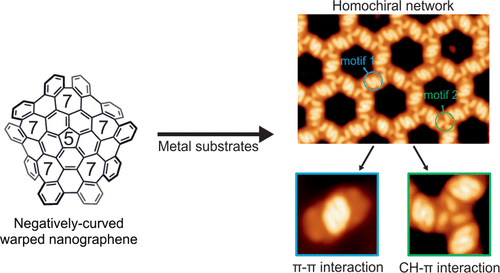


José I. Urgel, Marco Di Giovannantonio, Yasutomo Segawa, Pascal Ruffieux, Lawrence T. Scott, Carlo A. Pignedoli, Kenichiro Itami, Roman Fasel
J. Am. Chem. Soc. 2019, 141, 13158-13164. DOI: 10.1021/jacs.9b05501
We report the investigation of a conjugated polycyclic hydrocarbon containing multiple nonbenzenoid rings and exhibiting negative curvature—the warped nanographene C80H30—adsorbed on several noble metal surfaces in an ultrahigh vacuum environment. From a detailed analysis of the molecular self-assembly at different molecular coverages via scanning tunneling microscopy and spectroscopy measurements in combination with theoretical modeling, the nature of the intermolecular interactions is unraveled. For high molecular coverages on Cu(111), the formation of homochiral porous networks is observed, which is rationalized by (i) intermolecular π–π interactions between neighboring C80H30 molecules that promote the formation of molecular dimers and (ii) enantioselective intermolecular CH···π interactions between the dimers. Such interactions are also observed after deposition of C80H30 molecules on Au(111) and Ag(111) substrates. Our results provide perspectives for the on-surface study of negatively curved nanographenes which open new avenues to the design of novel and functional chiral structures with potential use in the field of organic optoelectronics.